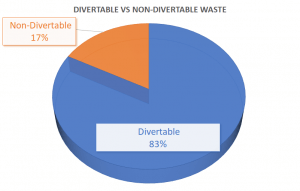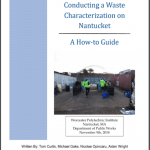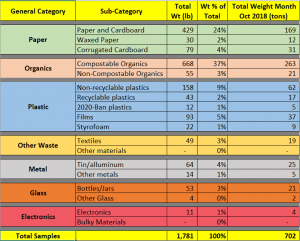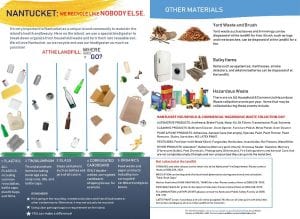Waste Characterization: Study & Outreach on Nantucket
Executive Summary
Introduction
Nantucket, Massachusetts is a unique, small island community that faces challenges similar to most other places of reducing landfill use and increasing recycling while reducing the wastes mixed with recycling material. Issues involving general waste and recycling management on Nantucket are exacerbated by Nantucket’s unique tourism environment; about 50,000 tourists and visitors arrive in the summer while there are only about 12,000 year round residents (Lajoie, 2017). The fluctuating population results in a remarkable increase of waste production. Unfortunately, the year-round waste stream, including the summer months, is often contaminated by recyclable items that could have been diverted from the landfill. To improve upon efforts to reduce, reuse, and recycle across the island, Nantucket has to better educate its residents and visitors on ways to improve adherence to the “3 R’s” approach. This requires a better understanding of the waste disposal habits of both the year-round residents and visitors of the island to help better understand the root of the problem.
The Nantucket Department of Public Works (DPW) has a long-standing mandatory recycling program on the island for residents, visitors, and commercial businesses, which focuses mainly on the recycling component of “reduce, reuse and recycle.” There is the Madaket Mall, where people can leave items such as clothes and books for others to take as a method of reuse. Nantucket also utilizes a special biodigester that breaks down any compostable material in the waste stream so that it can be re-purposed as soil. This feature reduces the use of the landfill. Because there had never been a waste characterization done on the island, the DPW staff had insufficient data for its website and for use in educational materials to help residents and visitors of Nantucket do a better job with recycling and improve their own waste management practices.
Mission Statement
Nantucket cannot effectively reduce landfill usage and improve recycling habits without conducting a waste characterization study to determine where and how contamination is occurring in their waste stream. The primary goal of this project was to develop and test a waste characterization process for the Nantucket DPW in order to recommend a repeatable waste characterization method. By repeatedly collecting data on what is going into the waste stream over time, the DPW can develop more focused messaging and outreach materials for the public.
Methodology
The specific goals, objectives, and tasks of this project were originally developed prior to arriving on the island. Subsequently, they evolved and were completed while working on site. The final list of objectives divided the project into three phases:
- Develop a method for and conduct a waste characterization study on a sample of waste from Nantucket.
- Evaluate and recommend a repeatable method for waste characterization based on research and the data collected during the test waste characterization study.
- Develop public outreach materials to help educate the Nantucket community on proper waste disposal.
To achieve the project objectives, the team applied research conducted on past waste characterization studies from other communities and the findings from a test waste characterization study on Nantucket to create a step-by-step guide detailing a waste characterization process. The data from the test waste characterization study was also analyzed based on the DPW’s interests with the intent of developing educational materials for community outreach and knowledge.
Data Analysis and Findings
Analysis of the data collected during the test waste characterization study on October 30th, 2018 led to several conclusions about Nantucket’s waste disposal habits. To start, during October 2018 the DPW collected 702 tons of municipal solid waste. After observing total waste trends across four years, the sample taken on October 29th, 2018 was concluded as representative of the month of October 2018. The sample was used to represent the distribution of waste collected during the entire off-season of 2018, divided into the categories shown in Table 1. As illustrated in the table, 119 tons (17%) out of an approximately 702 tons of waste are recyclable monthly. This recyclable waste includes corrugated cardboard, recyclable plastics, textiles, recyclable glass, tin/aluminum, and other metals.

Figure 2: Ratio of divertable to non-divertable materials by weight.
Because of Nantucket’s unique biodigester, it’s important to consider the comparison between compostable materials, paper and food wastes that will break down and be diverted, and non-compostable materials, which will ultimately go to the landfill. As shown in Table 2, the total percentage of compostable materials in the waste sample was 66%, while non-compostable materials made up the remaining 34%.
For Nantucket, recycling, composting, and the Madaket Mall are the only ways of diverting material from the landfill. All recyclable and compostable items make up the “divertable” section, illustrated in Figure 2. According to the data analysis, approximately 83% of the Nantucket waste stream could be diverted. Thus, public outreach materials were made to portray the importance of both recycling and composting on Nantucket.
Outcomes
Outcome 1: Recycling Posters for Public Outreach
To help increase knowledge about proper recycling techniques specific to Nantucket, explanatory posters were created. They are tailored to Nantucket’s unique system. There is one version of the poster designed for in-home use, and one designed to be displayed for people dropping-off their household waste at the DPW intake facility.
As shown in Figure 3, the poster drafts include pictured examples of common materials that belong in the various sorting receptacles that the DPW intake facility in Nantucket requires. The reverse side features items that are commonly confusing to dispose of. The posters are meant to act as references for community members who may not be sure how or where to dispose of something. The poster either directly informs the viewer on how to dispose of items (front side of poster, left side of Figure 3), or notes where they can find more information (back side of poster, right side of Figure 3).
Outcome 2: How-to Guide on Conducting a Waste Characterization Study

Figure 4: Title page of the draft
To ensure that the Nantucket DPW and other interested parties have a process to follow, a detailed guide for conducting a waste characterization study (Figure 5) was developed. The “How-to” Guide covers the logistics of a waste characterization study, detailing all necessary steps. The guide is divided into the three main sections: the planning phase, the action phase, and the analysis phase. A photo of the action phase is shown in Figure 4. The guide serves as a guideline and is meant to be adapted and changed depending on resources and intent of a sort.





